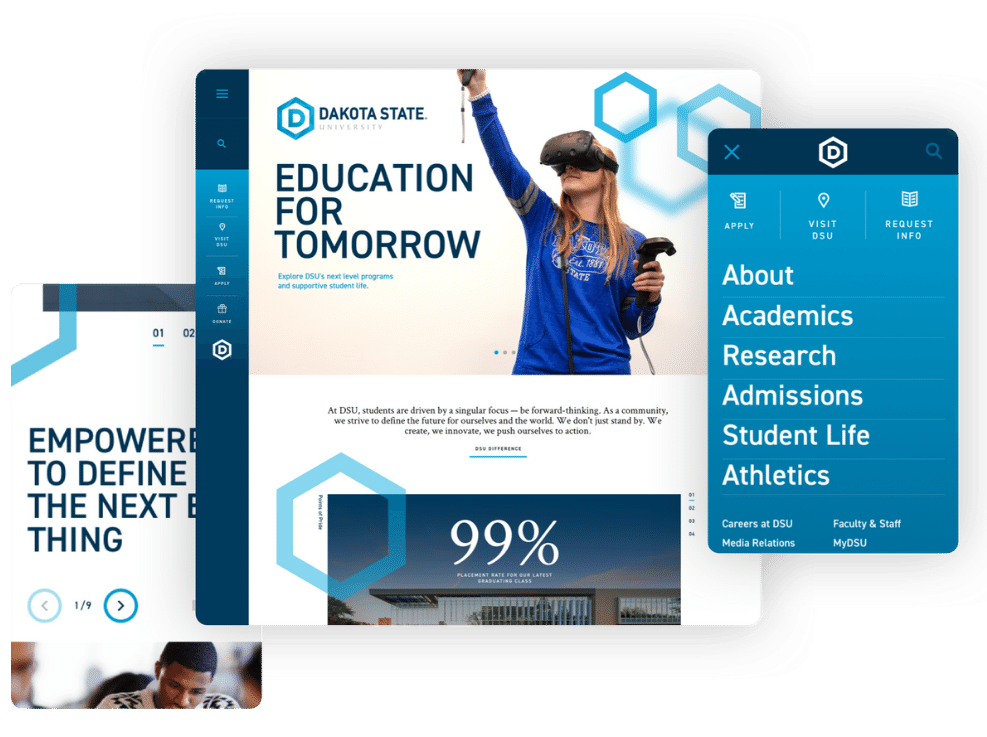The Role of Website Design in Enhancing Brand Identity and Recognition
The Role of Website Design in Enhancing Brand Identity and Recognition
Blog Article
Modern Site Design That Records Attention and Converts
In a significantly electronic landscape, modern web site layout has actually emerged as a pivotal variable in catching individual interest and driving conversions. As we check out these vital parts, it ends up being clear that recognizing their interplay can substantially impact a site's efficiency and customer satisfaction.
Importance of Visual Hierarchy
Visual hierarchy is an essential element in site design, as it guides customers' focus and boosts their total experience. By strategically arranging content, developers can guide individuals to the most essential details initially, thereby boosting engagement and boosting use. Effective visual hierarchy employs various techniques, consisting of size, spacing, color, and contrast. Larger aspects naturally attract the eye, while contrasting shades can emphasize crucial messages, making them stand apart among more restrained components.
Incorporating a sensible flow in web content arrangement is essential; for example, putting the most important information at the top of a web page cultivates immediate recognition. In addition, consistent use of typography, such as varying font sizes and designs, aids develop a clear web content framework. This organization not only help in navigation yet also develops trust fund, as users feel much more comfortable when they can quickly discover what they are looking for.
Ultimately, a well-executed aesthetic pecking order not only improves visual charm but also significantly impacts user actions. By focusing on essential elements and guaranteeing a smooth experience, designers can effectively convert visitors into clients, reinforcing the significance of this foundational design principle in contemporary internet site development.
Responsive Layout for All Tools
Developing a seamless experience across various tools is necessary in today's electronic landscape, where individuals gain access to internet sites from desktops, tablets, and smart devices alike. Receptive layout is an essential approach that makes sure web sites adapt fluidly to various display resolutions, dimensions, and orientations. By using adaptable grids, photos, and CSS media questions, designers can create designs that maintain visual integrity and capability, no matter the device being used.
The significance of receptive style prolongs past aesthetic appeals; it directly influences customer engagement and conversion prices. A site that functions well on all tools motivates longer sees and reduces bounce prices, as individuals are a lot more likely to connect with material that is very easy to navigate. Additionally, search engines, specifically Google, focus on mobile-friendly sites in their positions, making responsive layout a vital element of search engine optimization (SEARCH ENGINE OPTIMIZATION)
Integrating receptive layout not only improves user experience however additionally improves the growth process. By developing a solitary site that works across tools, services can save time and sources contrasted to establishing different mobile and desktop variations. Eventually, receptive layout is an essential method for modern-day web site style, guaranteeing ease of access and contentment for all users, despite their gadget.
Engaging Interactive Elements
While a responsive design prepares for a practical internet site, integrating engaging interactive elements is vital for recording customer focus and promoting much deeper links. Website Design. Interactive components, such as computer animations, tests, and clickable infographics, create a more dynamic customer experience, motivating site visitors to spend more time on the website
Including interactive attributes can also lead customers via facility information, making it easier to absorb web content. Interactive sliders can show product variants, while embedded video clips can supply presentations or reviews that reverberate more than fixed photos or message. Gamification strategies, like incentives for engaging or completing jobs with material, can boost individual inspiration and retention.
Efficient usage of interactive elements not just enhances the user experience but can additionally lead to greater conversion prices. It is vital to stabilize interactivity with performance; extremely complicated functions may impede website speed, adversely influencing customer complete satisfaction.
Streamlined Navigation Practices
Effective navigation is a foundation of any type of effective website, as it directly influences user experience and web my site content accessibility. Streamlined navigating practices make certain that individuals can easily find info, enhancing their interaction with the website. A well-structured navigating menu ought to be easy and instinctive, normally including a restricted number of main groups to avoid frustrating site visitors.
To accomplish streamlined navigating, designers must prioritize a hierarchical structure that practically arranges content. Implementing breadcrumb routes can give users with context about their existing place within the website, enabling seamless backtracking. Additionally, using drop-down menus can effectively preserve room while still supplying access to subcategories.
Receptive design is critical, as navigating should be useful across all gadgets (Website Design). Mobile users, particularly, take advantage of touch-friendly menus and retractable sections that keep functionality without endangering aesthetic appeals

Reliable Call-to-Action Techniques
A well-crafted call-to-action (CTA) is vital for directing customers toward desired outcomes on a site, as it encourages them to engage with web content or purchase. To optimize their effectiveness, CTAs ought to be clear, engaging, and purposefully put throughout the site.
First, make use of action-oriented language that interacts urgency or worth, such as "Begin," "Join Currently," or "Claim Your Discount rate." This language not just encourages users however additionally sets clear assumptions about the next actions.
Second, consider layout elements; CTAs ought to stand apart aesthetically with contrasting shades, sufficient whitespace, helpful hints and noticeable positioning. A button that is easy to see and click increases the possibility of individual communication.
Additionally, personalizing CTAs based on individual behavior or demographics can dramatically enhance involvement. Customized messages resonate much more with individuals, driving greater conversion prices.

Verdict
These elements jointly improve customer experience, making sure that site visitors remain involved and motivated to check out web content further. By focusing on these style concepts, services can substantially boost user retention and conversion prices, ultimately leading to better success in the digital landscape.
In an increasingly digital landscape, contemporary site design has emerged as a critical element in capturing user attention and driving conversions.Aesthetic hierarchy is a crucial aspect in site style, as it overviews individuals' focus and improves their total experience.The importance of receptive style prolongs past aesthetics; it directly impacts individual involvement and conversion rates.Integrating receptive design not only boosts individual experience however also simplifies the development process. Inevitably, responsive design is a basic approach for contemporary site layout, making certain availability and contentment for all users, no matter of their device.
Report this page